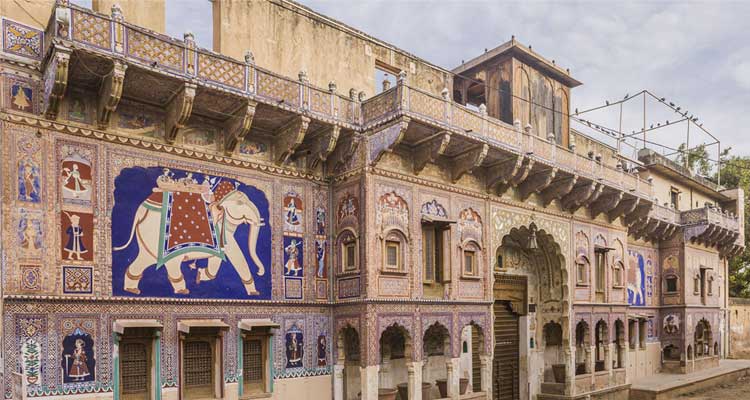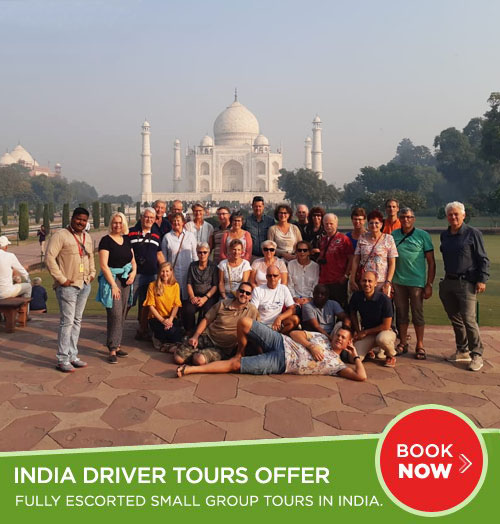
Shekhawati is a tourist’s paradise. The land is laced with innumerable beautiful havelis or grand mansions that are guaranteed to capture one’s imagination. It is a haven for a true connoisseur of art and architecture. A riot of colours encapsulates the spirit of this vibrant landscape. Exquisitely embellished havelis mushroomed during the eighteenth century and former half of the twentieth. Mythology and fauna lies at the very core of this wonderful art. Tales narrating the valour of Lord Rama and the miracles of Lord Krishna unfold on a journey of these marvellous mansions. The region also houses towering forts, baoris, and shrines, besides the ubiquitous havelis.
KANHAIYALAL BAGLA HAVELI
Kanhaiyalal Bagla Haveli is a beautiful structure, which stands on the south of the main bazaar. Constructed in around 1880, the haveli represents the finest lattice work and architectural styles in the entire Shekhawati region. The murals and wall paintings of the haveli depict Dhola and Maru, the romantic couple from folk tales, on a camel. The walls of the haveli are also adorned with the episodes of Dhola- Maru, the lovers fleeing on their camel.
SETHANI KA JOHARA
Sethani Ka Johara lies on the north side of the road perhaps 5 km west of Churu along the Ratangarh road. It is perhaps the finest johara (reservoir) in the area in that it is not only attractive but also efficient, holding a store of water, often from one monsoon to the next. It was built in 1899 by the widow of Bhagwan Das Bagla as part of the famine relief projects that the merchants financed in those terrible years of the close of the century. A peaceful place, it attracts various birds and animals, including Nilgais, in winter.
RAMGARH
Ramgarh was founded in 1791 by the Poddar family, and back then, was considered one of the richest towns in 19th century India. Ramgarh is famous for its paintings, old temples, cenotaphs and havelis. While Ramgarh has a lot to offer in terms of sightseeing, the Ramgopal Chhatri (cenotaph) and Poddar’s Haveli are especially popular among tourists.
LAXMANGARH FORT
Laxmangarh stands tall as the most impressive building in Laxmangarh town, looming majestically over the well laid township on its western side. An exceptional specimen of fort architecture in the entire world, Laxmangarh Fort is built upon scattered pieces of colossal rocks. The top of the ramp offers a fascinating bird’s eye view of the Laxmangarh town modeled to resemble the city lay out of Jaipur – Rajasthan’s bustling capital city.
RAGHUNATHJI MANDIR
Raghunathji Mandir, also known as Bara Mandir, is located in the vicinity of the Ratangarh town. Dedicated to Lord Raghunath or Rama, an incarnation of Lord Vishnu, the temple is believed to be constructed in early 19th century. It is a single storied temple with an elevated entrance. The top of the temple has a series of cupolas. The temple is believed to liberate one from the pains of life.
FATEHPUR
The city of Fatehpur was established by Kayamkhani Nawab Fateh Mohd in 1508 AD. He also constructed the Fort of Fatehpur in 1516. The city once served as the capital of Sikar. Today, Fatehpur is popularly known as the culture capital of Shekhawati. It is full of stunning sights to visit, of which, the Dwarkadheesh Mandir, Singhania Haveli, Nadine Le Prince Cultural Centre and Fatehchandka Haveli are the more notable ones.
SUNSET POINT MODA PAHAR
Moda Pahar is popular spot for watching the sunset. With the beautiful Ajit Sagar Lake by its foot, this spot attracts many migratory birds and Barasinghas. The raw beauty of this spot makes it a favourite with the tourists.
By Air
- The Jaipur Airport is the closest and is located 150-170 kilometres away.
By Road
- Sawai Madhopur is well connected with all the major cities and town through state bus service as well as private buses and taxis.
By Train
Moda Pahar is popular spot for watching the sunset. With the beautiful Ajit Sagar Lake by its foot, this spot attracts many migratory birds and Barasinghas. The raw beauty of this spot makes it a favourite with the tourists.
RANI SATI MANDIR
Rani Sati Mandir is a well-known temple situated in Jhunjhunu district in the Rajasthan. This temple has a history of more than 400 years and is an indication to feminine bravery and spirit. It is also famous for its magnificence, and extraordinary paintings. It is also part of one of the oldest presented Indian pilgrimages.
ALSISAR
Alsisar, a small town in Jhunjhunu is surrounded by arid dessert. Alsisar was awarded to Thakur Samarth Singh by his father, Thakur Pahad Singh of Heerwa, who made it his capital in 1783 AD. The famous Alsisar Mahal, a fine example of Rajput architecture with its fresco carvings and depiction of historical events on its walls, was built by Shekhawat Thikanedars. Alsisar is renowned for its Rajasthani hospitality, and tourists flock here to get a taste of that along with its famous castles, havelis and cenotaphs. Make sure you pay a visit to the Kejriwal Haveli, Laxmi Narayan temple, Thakur Chaatu Singh’s cenotaph, Ram Jas Jhunjhunwala Ki Haveli among others.
NAWALGARH
Located midway between Jhunjhunu and Sikar, Nawalgarh is well-known for its stunning havelis. It is also a favoured spot for film makers and many Indian and International movies have been shot here. A famous attraction here is the Nawalgarh Fort, which was built by Thakur Nawal Singh. The Roop Niwas Palace, located one km from Nawalgarh fort is a charming palace with beautiful gardens and fountains. It is now a heritage hotel.
How To Reach Shekhawati.
By Air
- The nearest Airport is Jaipur- 113 Kms
By Road
- There are direct buses from Delhi and other major cities of Rajasthan to Shekhawati.
By Train


